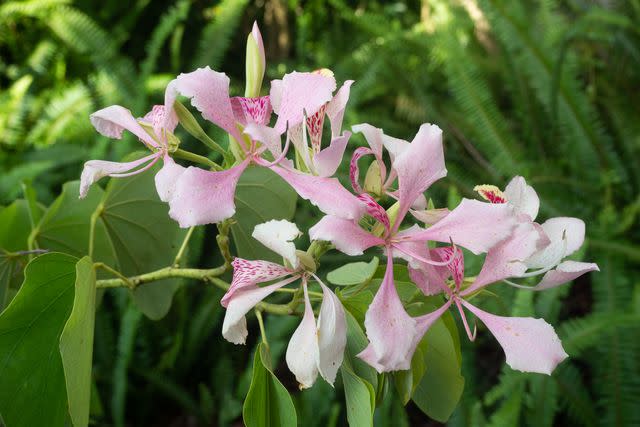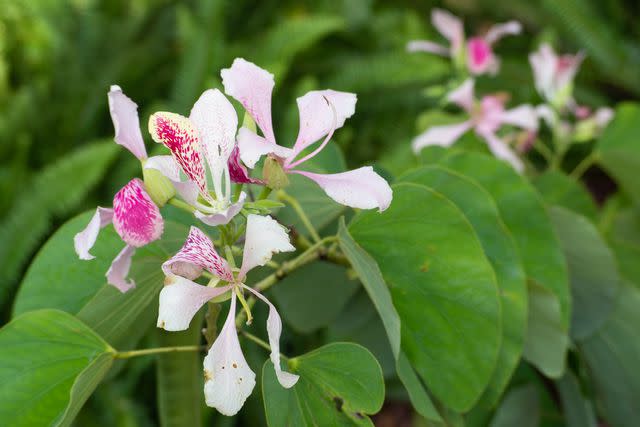How To Grow And Care For Orchid Tree
This colorful blooming tree looks like something from a dream, but it’s found everywhere in Southern Florida.

Southern Living/Valerie de Leon
The orchid tree (Bauhinia) fills with flowers that resemble those of an orchid, the blooming houseplant. Its light green leaves resemble butterfly wings. When planted in the Tropical South, the evergreen varieties of orchid tree look great for most of the year. Other varieties go quiet for the winter season. Available in a lot of different varieties, orchid tree needs the warm, sunny climate found in the tropical southern reaches of Florida. The showy trees grow quickly and need a wide area to grow in to accommodate their large canopy. They don't tolerate cold and thrive in sun and heat. While they can take shade, full sun produces more flowers in brighter colors. Plant in moist, well-drained soil in early spring so the plant will be established before summer temperatures rise. Here's what to know to grow and care for orchid tree. Some species of the tree are invasive in Florida.
Plant Attributes
Common Name | Orchid tree |
Botanical Name | Bauhinia |
Family | Fabaceae |
Plant Type | Tree, shrub |
Mature Size | Varies |
Sun Exposure | Full |
Soil Type | Loamy, well-drained |
Soil pH | Acidic, neutral |
Bloom Time | Varies |
Flower Color | Red, pink, purple |
Hardiness Zones | Zones 10-11 (USDA) |
Native Area | Asia, Africa |

Southern Living/Valerie de Leon
Orchid Tree Care
Orchid tree needs a warm and sun-filled climate, making southern Florida an ideal place to grow. Give the tree landscape fertilizer and water sparingly. Normal rainfall is generally enough moisture, but in extreme drought conditions, water the orchid tree with your garden hose. Some pruning will help the orchid tree take the shape you prefer, but it’s not required.
Light
Orchid tree grows best in full sun. It will tolerate partial sun, but full sun will bring out full flowers and the best colors.
Soil
Plant orchid tree in loamy, neutral soil that drains well. When planted in alkaline soil, the leaves turn yellow.
Water
Orchid tree thrives in the heat and humidity of our tropical south. Put your orchid tree on a moderate, but regular watering schedule and make sure the soil drains well. This plant doesn’t want to sit in water and won’t do well if overwatered.

Southern Living/Valerie de Leon
Temperature and Humidity
Orchid tree grows in Zones 10-11 (USDA) in the tropical south. Native to tropical parts of Asia and Africa, it grows best in sunshine and humidity.
Fertilizer
A general landscape fertilizer will provide a balance of nutrients the orchid tree needs to perform well. Ask your nursery for the product that suits your growing conditions.
Types of Orchid Tree
Hong Kong Orchid Tree (B. x blakeana): This partially deciduous tree is native to southern China. This showiest and most coveted bauhinia is also the least cold hardy. It grows to 20 feet high and wide in an umbrella-type habit. Flowers are much larger (to 6 inches wide) than those of other bauhinias and appear in late fall to spring. They are shaped like some orchids; colors range from cranberry-maroon through purple and rose to orchid-pink, often in the same blossom. Gray-green leaves tend to drop off around bloom time, but the tree does not lose all of its foliage.
Brazilian Orchid Tree (B. forficata) (B. candicans): This evergreen to deciduous large shrub or tree grows in Zones 9-11 (USDA) in CS, TS. Native to Brazil, it bears narrow-petaled, creamy white flowers to 3 inches wide from spring through summer. Deep green leaves with lobes are more pointed than those of other species. The tree grows to 20 feet tall and broad, often with a twisted, leaning trunk, picturesque angled branches, and short, sharp thorns at branch joints. It makes a good patio canopy. In the Tropical South, give it some afternoon shade; when unshaded, blooms tend to shrivel during the day.
Red Bauhinia (B. galpinii) (B. punctata): This evergreen to semievergreen shrub is native to tropical and southern Africa and is good for Zones 9-11 (USDA) in CS, TS. Brick-red to orange, 2.5- to 3-inch flowers, as spectacular as those of bougainvillea, bloom from spring to fall. The sprawling, half-climbing plant grows to about 10 feet tall, spreading to 15 feet. It is best as an espalier on a warm wall, and with hard pruning, it can make a flowering bonsai for a large pot or box.
Anacacho Orchid Tree (B. lunarioides) (B. congesta): This evergreen to semievergreen shrub or tree grows in Zones 9-11 (USDA) in CS, TS. It is native from southwestern Texas into northeastern Mexico. Maturing at 8–12 feet high and 4–5 feet wide, with rounded, very small leaves (1⁄2 to 3⁄4 in. long), this variety has white- and pink-flowering forms that bloom in early spring and repeat through spring and summer. It grows open structured in afternoon shade and is bushier in full sun.
Purple Orchid Tree (B. variegata) (B. purpurea): This is the most frequently planted species. These partially to wholly deciduous large shrubs or trees are Native to India and China and are hardy to 22°F. They prefer areas where spring is reliably and steadily warm. Light pink to orchid purple, broad-petaled, 2- to 3-inch-wide flowers usually bloom January to April. Light green, broad-lobed leaves generally drop in mid-winter, and a huge crop of messy-looking beans appear after blooming. Trim beans off if you wish—trimming brings new growth earlier. Staked and pruned, it becomes an attractive tree to 25–30 feet tall and wide, but it is Inclined to grow as a shrub with many stems. ‘Candida’ is the same, but with white flowers. This species is known to be invasive in Florida.
Sierra Orchid Tree (B. macranthera): This evergreen to semi-evergreen shrub grows in Zones 9-11 (USDA) in CS, TS. Native to eastern Mexico, it grows 8 feet high and 12 feet wide and blooms intermittently from spring through autumn, bearing small, exotic-looking flowers that combine tones of lavender and purple. It features attractive, glossy green leaves.
Butterfly Flower, Jerusalem Date (B. monandra): This deciduous shrub or small tree is native to tropical Asia. It is similar to B. variegata but is 20 feet tall and wide. Clusters of 4- to 5-inch-wide, pale pink to magenta blossoms, streaked or spotted with purple, come in clusters at the ends of branches. The tree typically flowers in summer, but in Florida bloom time may run from spring through late fall.
Pruning
Orchid trees naturally grow in a multi-trunk tree form, but if you prefer a single trunk, get a pair of sterilized loppers and start trimming those branches when it is young. Regular pruning will be required to hold the shape of an orchid tree. Regardless, every orchid tree will benefit with some pruning after it blooms. Remove any leggy or damaged branches once a year.

Southern Living/Valerie de Leon
Propagating Orchid Tree
Some varieties of orchid trees such as Bauhinia x blakeana are hybrids and do not produce seeds. These are best propagated by cuttings. Late spring or early summer are the best times to propagate. Here’s how:
Choose a green stem that is healthy and blemish free and cut it with clean pruning shears.
Remove lower leaves.
Dip the cut end in rooting hormone.
Plant the cutting in a pot with well-draining soil.
Cover the cutting with a plastic bag to create humidity and keep the soil consistently moist.
Place the pot in a location with bright, indirect light.
Use a heat mat if needed to provide warmth on cool nights.
How To Grow Orchid Tree From Seed
The best time to plant orchid tree seedlings is during spring. Collect seed pods during fall when they have turned brown and dried out. Remove seeds from the pods and soak seeds in warm water for 24 hours before planting. Add well-draining, sandy soil to a small pot and sow the seeds one-half inch deep. Water the seeds and cover with plastic to create a greenhouse environment. Place the pot in a sunny location and keep the soil moist. Germination can take weeks to months. Remove the plastic when seedlings appear. Plant seedlings in a sunny, well-drained location.
Common Pests and Plant Diseases
As a general rule, orchid trees do not have pest problems, but they can be frequented by caterpillars who want to munch on leaves. If they become a problem, try a commercial, eco-friendly insecticide containing Bacillus thuringiensis. This natural bacteria creates a protein that is toxic to insects when eaten.
How To Get Orchid Tree To Bloom
If your orchid tree fails to produce blooms, take a sunlight inventory. It should be planted in full sun, but sometimes changes in the landscape can block some of the needed light. (Think about larger trees that have outpaced orchid tree’s growth or your neighbor’s new fence or other structural changes in the neighborhood.) If possible, adapt your location to bring on full sun.
Common Problems With Orchid Tree
Orchid trees do not have too many problems, but when they do, it’s often due to environmental causes. If leaves are dropping or turning brown or yellow, here’s what it means.
Leaves Turning Brown
If orchid tree leaves turn brown, it’s likely due to watering. Dry heat or drought can cause the edges to turn brown. Established plants are more drought tolerant.
Leaves Turning Yellow
Yellow leaves also indicate a watering problem. Often the tree is being overwatered. Find a balance between too much and too little water, as both can cause problems for the tree. Soil should be moist but not soggy.
Dropping Leaves
Orchid trees may drop leaves seasonally, but if they are dropping suddenly and in large amounts, there may be a problem. Check to see if leaves are brown or yellow or show signs of disease. Give the tree adequate water and sunlight, and use a fungicide if disease is present.
Frequently Asked Questions
What is the life span of orchid trees?
These trees grow quickly and have a long life span. They mature at about 35 feet tall and can live for 50 years or more.
Are orchid trees messy?
Some varieties of orchid trees can be messy. They drop spent flowers, seed pods, and leaves after blooming. Some gardeners don’t mind the mess since the blooms last a long time. Some varieties are hybrids that don’t produce seed pods, and they are considered less messy.
Where is the best place to plant an orchid tree?
These trees prefer full sun. Plant them in a sunny spot where they will be sheltered from strong wind. Because their wood is not extremely strong, they are susceptible to damage from wind and weather.

Southern Living/Valerie de Leon
For more Southern Living news, make sure to sign up for our newsletter!
Read the original article on Southern Living.

